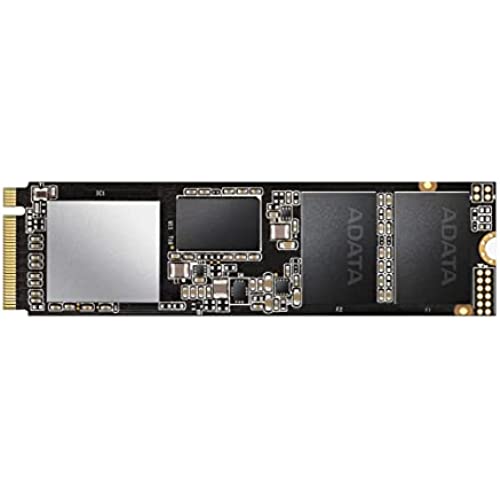
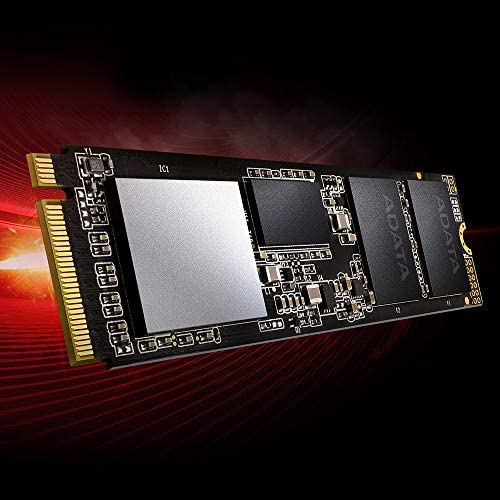
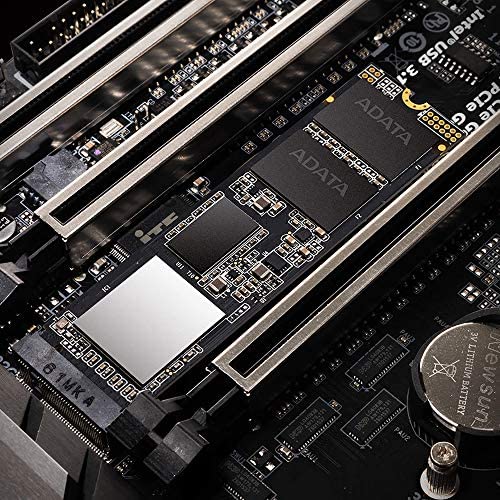
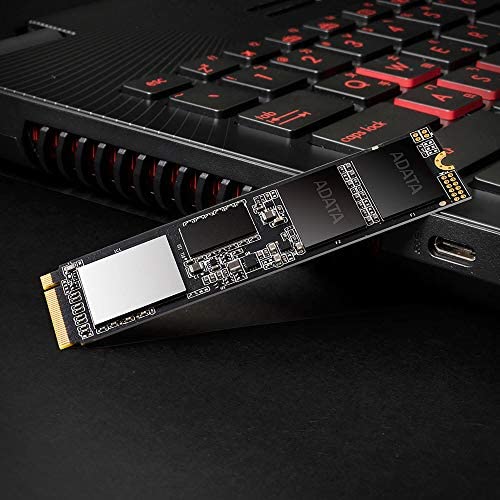
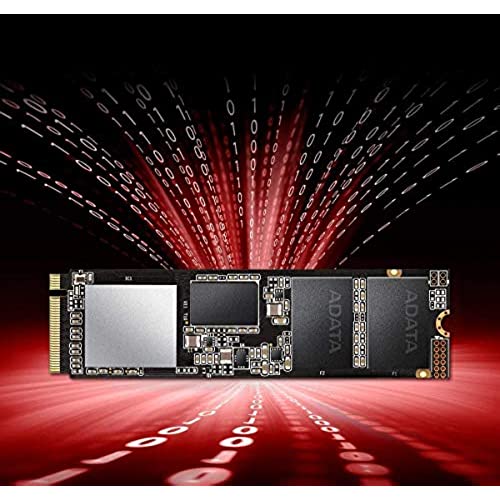
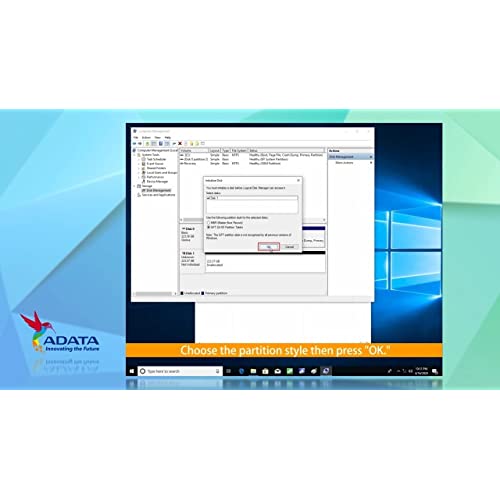






XPG SX8200 Pro 2TB 3D NAND NVMe Gen3x4 PCIe M.2 2280 Solid State Drive R/W 3500/3000MB/s SSD
-

A.Smith Family
> 24 hourGreat value for money. Preforms as described has some neat toolbox you can download from the company. You get a nice little heat deflector that looks good check out the pic. Also you get a copy of Acronis if you register. Which is great and a very helpful tool for disc imaging and cloning. So if your in the market for an affordable 512gb this hasnt let me down go for it.
-

Eric XYZ
> 24 hourExcellent M.2 Work on iMac 2017 27”
-

Bob in CLE
> 24 hourI bought this to upgrade an HP EliteDesk 800 G2 small form factor desktop, with an I7 6700. Obviously, not a gaming machine. I wanted something a little larger and a little faster than the 256 gig SSD it came with. Im very happy with my purchase. Ive bought dozens of Adata drives and never had a problem. My motherboard does not have an NVME slot. So, I bought the $8 adapter in the pic. amazon.com/gp/product/B07VYWR91T/ref=ppx_yo_dt_b_asin_title_o00_s02?ie=UTF8&psc=1 The adapter board was shipped, attached to the larger of the two brackets it was supplied with. I removed the bracket, installed the new drive, then attached the board to the low profile bracket. When I installed the board and powered up, bios and Windows 10 recognized the new drive immediately. I cloned the SSD to the new drive using the free version of Aomei Backupper. I find it less troublesome than other software. Afterward, powered down, removed the old drive and was up and running. All of this in a matter of minutes. I ran Crystal Disk Mark and the pic shows the results. Not bad. Im running the cpu, with turbo boost disabled, because it runs too hot when using video editing software. To see if read and write scores would improve, I enabled turbo boost. I got slightly lower scores. I dont know why. I dont really care either. Im happy.
-

mr618
> 24 hourall the talk about Ohhhh adata switched the controllers, it wont get over 1200mbps speeds is absolute rubbish! Heres proof from my order on 12/30/2020 from crystaldiskmark, photos attached and i easily acheived 3,400+ Read and 2700+ write, ANDDDDD that isnt even in an M.2 slot on my Motherboard.. its on a PCIE to m.2 adapter i have underneath my 2080 super because i have both the m.2 slots populated already! so im sure it would be even faster if i had it in the actual slot and not a 15$ PCIE to m.2 adapter... NOWWW on to the review Review is this... cheaper than samsungs rip off SSDs that youre literally paying pcie gen 4 prices for gen 3 nvmes.. nice storage capacity, plug and play and super simple.. i have over 100 TERABYTES worth of a media server for my friends and family i maintain (legally ;) ) and have an entire NAS full of these sticks, as well as IRONWOLF Red drives.. theyve been running for almost an entire year solid without a hitch.. so the stability and reliability is there! TL:DR if you can get it cheap enough, as in 30$ less than a 970 Evo plus/Evo... its a no brainer!! BUTTTT i will say ADATA IS SHADYYYYYYYYYY for not letting the public know about the behind the scenes controller swap! thats absolutely HORRID business practice but seeing as it probably doesnt have much affect on real world speed, i went ahead and bought it for 89$.. had this of been full price.. NOPE.. corsair or samsung would of got my business! overall solid SSD
-

Nathaniel D. Torbett
> 24 hourIve attached actual performance benchmarks from CrystalDiskMark in the images, both for a single drive and for the drives in RAID 0 configured as the boot volume. As you can see there is a slight boost for using RAID on sequential reads and a noticeable bump to writes. The drives installed easily, setting up RAID was a breeze thanks to ASUS/Intel RST. Windows 10 Pro installed smoothly and worked first time out. So, why not 5 stars? This model is listed as being supported by ADATAs SSD Toolbox software. This software is the only way to update the firmware and offers optimization, diagnostics and utilities that Id like to try out. In RAID 0 the drives arent recognized by the SSD Toolbox application. I contacted technical support who informed me the software would not work in conjunction with a RAID volume. This is understandable because the RAID controller is masking them into a single volume. I then wiped the RAID volume and re-installed Windows 10 onto a single drive, however, even when not combined into a RAID volume where the drives are independently recognized by the OS, the software still does not see the drives. I reached out to technical support again with screenshots demonstrating the issue and the response was to uninstall/reinstall the software. I did this, no joy. Interestingly, my Samsung SATA III SSDs were both recognized. They pointed out that there is not a firmware update needed currently but things may get complicated as time goes and updates come. As of this writing, no solution to get the software to recognize the drives under normal conditions. Im not satisfied by the support, as they seem to be dodging any actual assistance and e-mail responses take an entire day between steps/recommendations. Below is the system I have the drives installed in currently. Its a home productivity workstation and planned to be a gaming rig after some key upgrades down the road. Namely would like to replace the CPU with an i7-9700k and add an RTX 2080 Ti. 1x Asus ROG Maximus XI Hero Wi-Fi Z390 1x Intel Core i3-8100 Coffee Lake Quad-Core 3.6 GHz LGA 1151 300 Series 65W 1x Kingston Technology HyperX Fury Black 32GB 3200MHz DDR4 CL18 DIMM Memory (HX432C18FBK2/32) [Kit of 2 16GB Modules] 2x Adata XPG SX8200 Pro 1TB 3D NAND NVMe Gen3x4 PCIe M.2 2280 SSD [Intel RST RAID 0, Boot Drive] 1x Samsung 850 PRO 256GB 2.5 SATA III Internal SSD (MZ-7KE256BW) 1x Samsung 860 EVO 500GB 2.5 SATA III Internal SSD (MZ-76E500B/AM) 1x G-Technology 4TB G-Drive USB-C (USB 3.1 Gen 1) External Hard Drive (0G05666) 1x Corsair Carbide 275R Mid-Tower Gaming Case - Tempered Glass - Black (CC-9011132-WW) 1x Corsair AX1600i 1600W ATX 80 Plus Titanium Certified Full Modular Digital ATX Power Supply (CP-9020087-NA) 1x Windows 10 Professional
-

Kinomora
> 24 hourUpgraded from a pretty cheap SSD which wasnt super fast or large. This M.2 SSD runs the NVMe protocol over PCIe 3.0 at x4 lanes. This is not a SATA M.2 drive. Not all motherboards provide M.2 NVMe SSD slots, make sure yours is compatible! Additionally, if you plan to install Windows (or any other OS for that matter) on this drive, check the manufacturers webpage or manual to validate whether or not it is capable of booting to an NVMe SSD in the first place. I installed this drive into my Biostar GT5 X370 Racing motherboard for AM4 with a Ryzen 2600. When loading into Windows still installed on my old drive, it was fine- detected right off the bat (you may need to open Disk Manager and initialize the disk before it shows in Explorer) and the speed at which it accepted and loaded files was amazing. My trouble came when trying to install Windows to it. At first I thought it would be a simple clone job, moving from one SSD to another- turns out, there are some BIOS settings that need to be changed. I spent nearly 3 days working through tutorials and guides trying to get this working, and Im not sure what combination of them caused it to finally work, but what seems to finally make it successful was disabling secure boot and disabling CSM in the bios, then inserting a windows installation USB drive, deleting the partition on the drive and formatting it, and finally allowing the installer to create the required 4 partitions for GMT. I now have Windows successfully installed on the drive and its amazing, really, if you dont have an SSD in your system youre missing it. I press the power button and as soon as the bios screen fades the desktop is already there. Applications load almost instantly, installations are lightning fast, this drive rivals the top of the line Samsung Evo and Pro SSDs in terms of speed, at half the cost. In highly recommend this to anyone looking to increase the performance of their system without breaking the bank.
-

Kevin Lee James
> 24 hourGetting good performance from the 1TB drive and, on paper at least, it seems relatively on par with a Samsung drive for the most part and at about $40-50 less. I say on paper since I havent really done anything to push this drive since Im just using it as a boot drive and not for any extreme storage scenarios. The only drawback is that the SSD endurance is only 640 TBW, but as long as its being used for games or boot, I dont see this as a big deal. As a boot drive, it was super easy to install and the fact that it came with an optional heat spreader is great... although, it mostly just a thin piece of metal with some pre-applied thermal compound -- nothing fancy. Performance-wise its definitely an improvement over my old 850 EVO SATA SSD. I say go for it if youre on a budget and need a solid NVME SSD.
-

Aviv M
> 24 hourI work in IT and have over a dozen of these as well as pretty much every other SSD on the market. As many reviews in 2020-2021 mention, they did switch over an important part to something inferior, but that happens from time to time and Im not going to focus on this, I am just reviewing this as it is regardless of how much better and cheaper it was before. SPEED -- 1/5 This is worse than a SATA SSD that you can purchase at a lower price. Fully empty, when you initially benchmark it, it barely even gets the advertised speed. This is on the most optimal conditions, and even under these, the benchmark looks like PCIe Gen3 x 2 and not Gen3 x 4. This is bad. It cant outperform something 30% cheaper that came out years ago. CONSISTENCY - 0/5 The absolute worst drive of any kind I have seen in my entire life. Writing a SEQUENTIAL test file to fill half the disk took 59 minutes, so about an average of 290MB per second, so maybe a really really old Samsung SSD from 8 years ago. This was jumping around from 2GB/s to 4GB/s for the first 15 seconds maybe just enough to cheat on a benchmark and then immediately all over the place, not even 100GB written when it went from 1GB/s to 60MB/s and 1.3GB/s then 60MB/s, 500MB/s to 60MB/s, 200-800MB/s, then maybe halfway through 100-200MB/s (this is where it was most stable if you want to call it that.) Its like using a random number generator for performance. TECHNOLOGY - 0/5 This uses SLC caching, has DRAM cache, basically a bunch of advanced methods to make it better and it performs worse than any drive Ive seen without any of that stuff. This is apparently TLC which is supposed to be superior to QLC. Basically, QLC tries to cram more. QLC is supposed to be slower, and less durable. This somehow performs about half as good as the same brand QLC which is baffling because the other model is supposed to be actually based on the XPG 8100, not the XPG 8200 PRO. As in, a 4TB version of this (double 2TB) that costs less than 2 times more even though 4TB is supposed to go up exponentially in price, performs better and more consistent as QLC than this TLC thats supposed to be the superior model of the same brand. VALUE - 0/5 This is where Ill quickly mention that the old version apparently was good, and therefore it means this is overhyped. No one bothers to update their reviews and no one bothers to research it further so they all immediately read or see something online and think this is a great value. Since XPG knows this, they basically charge way more for this model due to the high demand even though to give them some credit, XPG seems to have other better models. For some reason, and I doubt it was due to bad intentions, they had to switch the controller on these and it happened to be a bad choice. I think XPG probably ended up getting bait and switched by Silicon Motion, the supplier for the controller. Apparently this newer version thats bad is SM2262G and the old one is SM2262EN, but they did the switch over because the old version, although it performed almost on par with some of the best drives like Samsung (at a lower price, at the time) it had a shorter life. So I assume they switched over to this one to make it more reliable and ended up absolutely thrashing performance. Again, to be fair, this XPG 8200 Pro does have a good warranty, assuming they honor it properly. This is unfortunately the trade-off youll make unless you end up paying double for enterprise NVMe SSDs: the more consistently fast it is, the more likely it is to die 2-3x sooner. LIFE - 3/5 I have no reason to believe the life of this product would be lower than similarly priced NVMe SSDs. Since its TLC, itll have a better life by default versus QLC. The amount of writes you have to do to the drive to void the warranty is 1.5-3x more than competitors but I guess their strategy is to make sure you can never physically write that much to the disk by making it slow! TBW is 1280 which basically means you can write 700GB to it every day for 5 years. This means youd have to constantly write to it at about 8MB per second, or about 24MB/s assuming youre only using the computer 8 hours a day, lets say for work. This card will probably struggle to do that depending on what youre doing with it, how small the files are; the random speed test as I was constantly using it was probably about 27MB/s so barely above this threshold. So they do literally try to keep you from ever reaching that point by just making sure its slow and bad. GET ANY OTHER DRIVE. LITERALLY ANY OTHER ONE.
-

Jay D.
> 24 hourTook a lot of time just to get the results that Ive posted. And if you use this ssd as your C drive make certain that you look to see what your original drive is and adjust the new one accordingly (i.e. MBR or GTP). Your bios might see it but the system may not boot if its setup incorrectly. Im OK with the results I received when testing although it would have been nicer if those results were a bit higher. Its sort of The luck of the Draw, never know what you might receive in terms of speed. I have the 1TB ADATA XPG SX8200 PRO 2280 and its installed in a Dell G5 15 5500 as D drive along with a 256GB NVMe PCIe M.2 2230 C drive and they work well together. UPDATE: The Writes, even though lower than advertised (2600MB/s sequential writes), they are pretty consistent at all levels of testing while the Reads, on the other hand, are all over the place and much much lower 1500~2300MB/s. I wont be buying this brand again nor will I recommend it either. UPDATE: 2.5 months later and the drive at 10 percent full reads just over 1600MB/S. The write speed has always maintained a speed of right around 2600MB/S but the read speed has been all over the place and now wont read over around 1600MB/S. I wont buy this again or recommend it either! Next time I think Ill try out the 1TB Samsung EVO Plus. Who knows, I might have better luck with that one. Update: Retuned the SSD for a replacement at the end of Nov. 2020. They were very quick with sending me a replacement, the only drawback though was that the replacement would only turn out 2000MB/S Max Read and the Write was much less. Returned that SSD and it was received by ADATA on the 15th of DEC. 2020. Havent heard from them since and its now 1/8/2021 and have requested a reply from them twice but to no avail. Well see what happens in the future and will update then. Update: The SX8200Pros were on backorder at ADATA (I thought they manufactured them... Oh well). Finally I received a third unit (another replacement from ADATA) and this one was ridiculous... 1,200MB/s Read & 2,300MB/s Write sequentially. Dont they check these before sending then to their customers? I just purchased a Crucial P5 500GB SSD just to make certain it wasnt my G5 5500 Dell Laptop that was messing things up and it came up with readings of 3,200MB/s Read and 2,900MB/s Write for it. Sorry ADATA, your SX8200PNP (PRO) is No Good! Heck with the money Im spending on shipping these units back to ADATA I could have purchased a Samsung. And fifth unit I received was terrible... Never again will I buy another ADATA anything.
-

A. Taylor
> 24 hourThis review is for the 1TB drive. This is important to note, because most of the negative reviews are from people who dont understand how these things work, or how they are listed on Amazon. That being said, lets move on. Installed this into a new build system, on a B450 Gaming Plus Max board, with a Ryzen 3600 chip. Drive came with the m.2 screw to properly mount to the motherboard. Installed Windows to the drive via USB, and the motherboard automatically selected it as the boot drive once that was done. I want to say that again. The drive 100% works as a boot drive, and once Windows is installed, any decent motherboard will automatically select it as the boot drive. Speeds are essentially as advertised on the read side, and about 10% better than advertised on the write side. In addition, it stays quite cool. Drive did not exceed 48c during testing via CrystalDiskMark. It DOES include a very thin heat spreader, which I did put on the drive. Not sure what impact it has, but hey, every degree matters! Currently idling at 36c.
